Daily Peer Relationships and Academic Achievement among College Students: A Social Network Analysis Based on Behavioral Big Data
Abstract
:1. Introduction
- Research Question 1: What factors are associated with the formation of daily peer relationships (reflected by attending classes, eating, and bathing) among college students after enrollment?
- Research Question 2: What are the characteristics of college students’ daily peer relationship networks?
- Research Question 3: What are the associations between college students’ daily peer relationships and their academic achievement?
2. Literature Review
2.1. Peer Relationships of College Students
2.2. Peer Relationships and Academic Achievement
3. Methodology
3.1. Data Collection
3.2. Construction of Daily Peer Relationship Networks and Community Detection
3.3. The Analysis of Academic Achievement
4. Results
4.1. The Descriptive Analysis
4.2. Formation and Evolution of College Students’ Daily Peer Relationship Networks
4.3. Network Characteristics of Daily Peer Relationships of College Students
4.4. Association between Daily Peer Relationships and Academic Achievement
5. Discussion and Conclusions
5.1. Main Findings
5.2. Theoretical Implications
5.3. Practical Implications
5.4. Limitations and Future Research
Author Contributions
Funding
Institutional Review Board Statement
Informed Consent Statement
Data Availability Statement
Conflicts of Interest
References
- Berger, C.; Deutsch, N.; Cuadros, O.; Franco, E.; Rojas, M.; Roux, G.; Sánchez, F. Adolescent Peer Processes in Extracurricular Activities: Identifying Developmental Opportunities. Child. Youth Serv. Rev. 2020, 118, 105457. [Google Scholar] [CrossRef]
- Smirnov, I.; Thurner, S. Formation of homophily in academic performance: Students change their friends rather than performance. PLoS ONE 2017, 12, e0183473. [Google Scholar] [CrossRef] [PubMed]
- Wang, G.; Hu, W. Peer Relationships and College Students’ Cooperative Tendencies: Roles of Interpersonal Trust and Social Value Orientation. Front. Psychol. 2021, 12, 656412. [Google Scholar] [CrossRef] [PubMed]
- Benson, J.E. Make New Friends but Keep the Old: Peers and the Transition to College. Adv. Life Course Res. 2007, 12, 309–334. [Google Scholar] [CrossRef]
- Lippke, S.; Fischer, M.A.; Ratz, T. Physical Activity, Loneliness, and Meaning of Friendship in Young Individuals—A Mixed-Methods Investigation Prior to and During the COVID-19 Pandemic with Three Cross-Sectional Studies. Front. Psychol. 2021, 12, 617267. [Google Scholar] [CrossRef]
- Sun, Y.; Lin, S.-Y.; Chung, K.K.H. University Students’ Perceived Peer Support and Experienced Depressive Symptoms during the COVID-19 Pandemic: The Mediating Role of Emotional Well-Being. Int. J. Environ. Res. Public Health 2020, 17, 9308. [Google Scholar] [CrossRef]
- Zhang, H.; Yang, J.; Li, Y.; Ren, G.; Mu, L.; Cai, Y.; Luo, Q.; Zhou, Y. The Patterns and Predictors of Loneliness for the Chinese Medical Students Since Post-Lockdown to New Normal with COVID-19. Front. Public Health 2021, 9, 679178. [Google Scholar] [CrossRef]
- Osgood, D.W.; Ragan, D.T.; Wallace, L.; Gest, S.D.; Feinberg, M.E.; Moody, J. Peers and the Emergence of Alcohol Use: Influence and Selection Processes in Adolescent Friendship Networks. J. Res. Adolesc. 2013, 23, 500–512. [Google Scholar] [CrossRef]
- Groom, A.L.; Vu, T.-H.T.; Landry, R.L.; Kesh, A.; Hart, J.L.; Walker, K.L.; Wood, L.A.; Robertson, R.M.; Payne, T.J. The Influence of Friends on Teen Vaping: A Mixed-Methods Approach. Int. J. Environ. Res. Public Health 2021, 18, 6784. [Google Scholar] [CrossRef]
- Wang, M.-T.; Kiuru, N.; Degol, J.L.; Salmela-Aro, K. Friends, Academic Achievement, and School Engagement during Adolescence: A Social Network Approach to Peer Influence and Selection Effects. Learn. Instr. 2018, 58, 148–160. [Google Scholar] [CrossRef]
- Berthelon, M.; Bettinger, E.; Kruger, D.I.; Montecinos-Pearce, A. The Structure of Peers: The Impact of Peer Networks on Academic Achievement. Res. High. Educ. 2019, 60, 931–959. [Google Scholar] [CrossRef]
- Van der Zanden, P.J.A.C.; Denessen, E.; Cillessen, A.H.N.; Meijer, P.C. Domains and Predictors of First-Year Student Success: A Systematic Review. Educ. Res. Rev. 2018, 23, 57–77. [Google Scholar] [CrossRef]
- Nelson, R.M.; DeBacker, T.K. Achievement Motivation in Adolescents: The Role of Peer Climate and Best Friends. J. Exp. Educ. 2008, 76, 170–189. [Google Scholar] [CrossRef]
- Raabe, I.J.; Boda, Z.; Stadtfeld, C. The Social Pipeline: How Friend Influence and Peer Exposure Widen the STEM Gender Gap. Sociol. Educ. 2019, 92, 105–123. [Google Scholar] [CrossRef]
- Chen, C.; Shen, Y.; Lv, S.; Wang, B.; Zhu, Y. The Relationship between Self-Esteem and Mobile Phone Addiction among College Students: The Chain Mediating Effects of Social Avoidance and Peer Relationships. Front. Psychol. 2023, 14, 1137220. [Google Scholar] [CrossRef] [PubMed]
- Wissing, R.O.; Hilverda, F.; Scheepers, R.A.; Nieboer, A.P.; Vollmann, M. Peer Relationships Buffer the Negative Association of Online Education with Education Satisfaction and Subsequently with Study Engagement among Undergraduate Medical Students. BMC Med. Educ. 2022, 22, 276. [Google Scholar] [CrossRef]
- Goguen, L.M.S.; Hiester, M.A.; Nordstrom, A.H. Associations among Peer Relationships, Academic Achievement, and Persistence in College. J. Coll. Stud. Retent. Res. Theory Pract. 2010, 12, 319–337. [Google Scholar] [CrossRef]
- Contreras, D.; González, L.; Láscar, S.; López, V. Negative Teacher–Student and Student–Student Relationships Are Associated with School Dropout: Evidence from a Large-Scale Longitudinal Study in Chile. Int. J. Educ. Dev. 2022, 91, 102576. [Google Scholar] [CrossRef]
- Brouwer, J.; De Matos Fernandes, C.A.; Steglich, C.E.; Jansen, E.P.; Hofman, W.A.; Flache, A. The Development of Peer Networks and Academic Performance in Learning Communities in Higher Education. Learn. Instr. 2022, 80, 101603. [Google Scholar] [CrossRef]
- Brouwer, J.; Engels, M.C. The Role of Prosocial Attitudes and Academic Achievement in Peer Networks in Higher Education. Eur. J. Psychol. Educ. 2022, 37, 567–584. [Google Scholar] [CrossRef]
- Kassarnig, V.; Bjerre-Nielsen, A.; Mones, E.; Lehmann, S.; Lassen, D.D. Class Attendance, Peer Similarity, and Academic Performance in a Large Field Study. PLoS ONE 2017, 12, e0187078. [Google Scholar] [CrossRef] [PubMed]
- Li, Y.; Li, S.; Wei, C.; Liu, J. How Students’ Friendship Network Affects Their GPA Ranking: A Data-Driven Approach Linking Friendship with Daily Behaviour. Inf. Technol. People 2019, 33, 535–553. [Google Scholar] [CrossRef]
- Tan, T.X.; Yi, Z.; Camras, L.A.; Cheng, K.; Li, Z.; Sun, Y.; Chen, N. The Effect of Academic Performance, Individualistic and Collectivistic Orientation on Chinese Youth’s Adjustment. Soc. Psychol. Educ. 2021, 24, 1209–1229. [Google Scholar] [CrossRef]
- Veeck, A.; Yu, H.; Zhang, H.; Zhu, H.; Yu, F. Social Eating Patterns, Identity and the Subjective Well-Being of Chinese Teenagers. Eur. J. Mark. 2018, 52, 2356–2377. [Google Scholar] [CrossRef]
- Dunbar, R.I.M. Breaking Bread: The Functions of Social Eating. Adapt. Hum. Behav. Physiol. 2017, 3, 198–211. [Google Scholar] [CrossRef]
- Cao, Y.; Gao, J.; Lian, D.; Rong, Z.; Shi, J.; Wang, Q.; Wu, Y.; Yao, H.; Zhou, T. Orderliness Predicts Academic Performance: Behavioural Analysis on Campus Lifestyle. J. R. Soc. Interface 2018, 15, 20180210. [Google Scholar] [CrossRef]
- Mouganie, P.; Wang, Y. High-Performing Peers and Female STEM Choices in School. J. Labor Econ. 2020, 38, 805–841. [Google Scholar] [CrossRef]
- Zhao, L.; Chen, K.; Song, J.; Zhu, X.; Sun, J.; Caulfield, B.; Namee, B.M. Academic Performance Prediction Based on Multisource, Multifeature Behavioral Data. IEEE Access 2021, 9, 5453–5465. [Google Scholar] [CrossRef]
- Yao, H.; Lian, D.; Cao, Y.; Wu, Y.; Zhou, T. Predicting Academic Performance for College Students: A Campus Behavior Perspective. ACM Trans. Intell. Syst. Technol. 2019, 10, 1–21. [Google Scholar] [CrossRef]
- Akhtar, S.; Warburton, S.; Xu, W. The Use of an Online Learning and Teaching System for Monitoring Computer Aided Design Student Participation and Predicting Student Success. Int. J. Technol. Des. Educ. 2017, 27, 251–270. [Google Scholar] [CrossRef]
- Juvonen, J.; Espinoza, G.; Knifsend, C. The Role of Peer Relationships in Student Academic and Extracurricular Engagement. In Handbook of Research on Student Engagement; Springer: Boston, MA, USA, 2012; pp. 387–401. [Google Scholar]
- Mauldin, R.L.; Barros-Lane, L.; Tarbet, Z.; Fujimoto, K.; Narendorf, S.C. Cohort-Based Education and Other Factors Related to Student Peer Relationships: A Mixed Methods Social Network Analysis. Educ. Sci. 2022, 12, 205. [Google Scholar] [CrossRef]
- Powazny, S.; Kauffeld, S. The Role of Gender in the Evolution of Peer Networks: Individual Differences in Relation to the Big Five. Personal. Individ. Differ. 2021, 170, 110447. [Google Scholar] [CrossRef]
- Marmaros, D.; Sacerdote, B. How Do Friendships Form? Q. J. Econ. 2006, 121, 79–119. [Google Scholar] [CrossRef]
- Thelamour, B.; George Mwangi, C.; Ezeofor, I. “We Need to Stick Together for Survival”: Black College Students’ Racial Identity, Same-Ethnic Friendships, and Campus Connectedness. J. Divers. High. Educ. 2019, 12, 266–279. [Google Scholar] [CrossRef]
- Mayer, A.; Puller, S.L. The Old Boy (and Girl) Network: Social Network Formation on University Campuses. J. Public Econ. 2008, 92, 329–347. [Google Scholar] [CrossRef]
- Ruan, D.; Zhu, S. Birds of a Feather: A Case Study of Friendship Networks of Mainland Chinese College Students in Hong Kong. Am. Behav. Sci. 2015, 59, 1100–1114. [Google Scholar] [CrossRef]
- Selfhout, M.; Burk, W.; Branje, S.; Denissen, J.; Van Aken, M.; Meeus, W. Emerging Late Adolescent Friendship Networks and Big Five Personality Traits: A Social Network Approach. J. Personal. 2010, 78, 509–538. [Google Scholar] [CrossRef]
- Steenberghs, N.; Lavrijsen, J.; Soenens, B.; Verschueren, K. Peer Effects on Engagement and Disengagement: Differential Contributions From Friends, Popular Peers, and the Entire Class. Front. Psychol. 2021, 12, 726815. [Google Scholar] [CrossRef]
- Zhou, N.; Ma, S.; Li, X.; Zhang, J.; Liang, Y.; Yu, C.; Geng, X.; Meng, J.; Yuan, X.; Cao, H.; et al. Peer Contagion Processes for Problematic Internet Use among Chinese College Students: A Process Model Involving Peer Pressure and Maladaptive Cognition. Comput. Hum. Behav. 2019, 90, 276–283. [Google Scholar] [CrossRef]
- Swenson, L.M.; Nordstrom, A.; Hiester, M. The Role of Peer Relationships in Adjustment to College. J. Coll. Stud. Dev. 2008, 49, 551–567. [Google Scholar] [CrossRef]
- Twenge, J.M.; Spitzberg, B.H.; Campbell, W.K. Less In-Person Social Interaction with Peers among U.S. Adolescents in the 21st Century and Links to Loneliness. J. Soc. Pers. Relatsh. 2019, 36, 1892–1913. [Google Scholar] [CrossRef]
- Brooks, R. Friends, Peers and Higher Education. Br. J. Sociol. Educ. 2007, 28, 693–707. [Google Scholar] [CrossRef]
- Han, Y.; Qin, G.; Han, S.; Ke, Y.; Meng, S.; Tong, W.; Guo, Q.; Li, Y.; Ye, Y.; Shi, W. Effect of Mobile Phone Addiction on Physical Exercise in University Students: Moderating Effect of Peer Relationships. Int. J. Environ. Res. Public Health 2023, 20, 2685. [Google Scholar] [CrossRef]
- Childers, C.C.; Haley, E.; Jahns, L. Insights into University Freshman Weight Issues and How They Make Decisions about Eating. J. Consum. Aff. 2011, 45, 306–328. [Google Scholar] [CrossRef]
- Kabir, A.; Roy, S.; Begum, K.; Kabir, A.H.; Miah, M.S. Factors influencing sanitation and hygiene practices among students in a public university in Bangladesh. PLoS ONE 2021, 16, e0257663. [Google Scholar] [CrossRef]
- Madigan, D.J.; Curran, T. Does Burnout Affect Academic Achievement? A Meta-Analysis of over 100,000 Students. Educ. Psychol. Rev. 2021, 33, 387–405. [Google Scholar] [CrossRef]
- Poldin, O.; Valeeva, D.; Yudkevich, M. Which Peers Matter: How Social Ties Affect Peer-Group Effects. Res. High. Educ. 2016, 57, 448–468. [Google Scholar] [CrossRef]
- DeLuca Bishop, H.K.; Baker, E.A.; van Dulmen, M.H.M. The Role of Friends and Romantic Partners in College-Attending Emerging Adults’ Engagement and GPA. Emerg. Adulthood 2023, 11, 221–233. [Google Scholar] [CrossRef]
- McEwan, P.J.; Soderberg, K.A. Roommate Effects on Grades: Evidence from First-Year Housing Assignments. Res. High. Educ. 2006, 47, 347–370. [Google Scholar] [CrossRef]
- Zeng, G.; Zhong, M.; Wu, W. The Fellow Effect on College Students’ Academic Performance. Front. Psychol. 2022, 13, 1055963. [Google Scholar] [CrossRef]
- Fischer, T.; Rode, J. Classroom or Pub—Where Are Persistent Peer Relationships between University Students Formed? J. Econ. Behav. Organ. 2020, 178, 474–493. [Google Scholar] [CrossRef]
- Lin, N. Social Capital: A Theory of Social Structure and Action; Cambridge University Press: Cambridge, UK, 2002; ISBN 978-0-521-52167-3. [Google Scholar]
- Delgado, M.Y.; Ettekal, A.V.; Simpkins, S.D.; Schaefer, D.R. How Do My Friends Matter? Examining Latino Adolescents’ Friendships, School Belonging, and Academic Achievement. J. Youth Adolesc. 2016, 45, 1110–1125. [Google Scholar] [CrossRef]
- Graham, J.; McClain, S. A Canonical Correlational Analysis Examining the Relationship Between Peer Mentorship, Belongingness, Impostor Feelings, and Black Collegians’ Academic and Psychosocial Outcomes. Am. Educ. Res. J. 2019, 56, 2333–2367. [Google Scholar] [CrossRef]
- Kiuru, N.; Wang, M.-T.; Salmela-Aro, K.; Kannas, L.; Ahonen, T.; Hirvonen, R. Associations between Adolescents’ Interpersonal Relationships, School Well-Being, and Academic Achievement during Educational Transitions. J Youth Adolesc. 2020, 49, 1057–1072. [Google Scholar] [CrossRef] [PubMed]
- Simonsmeier, B.A.; Peiffer, H.; Flaig, M.; Schneider, M. Peer Feedback Improves Students’ Academic Self-Concept in Higher Education. Res. High. Educ. 2020, 61, 706–724. [Google Scholar] [CrossRef]
- Golsteyn, B.H.H.; Non, A.; Zölitz, U. The Impact of Peer Personality on Academic Achievement. J. Political Econ. 2021, 129, 1052–1099. [Google Scholar] [CrossRef]
- Hwang, G.-J.; Wang, S.-Y.; Lai, C.-L. Effects of a Social Regulation-Based Online Learning Framework on Students’ Learning Achievements and Behaviors in Mathematics. Comput. Educ. 2021, 160, 104031. [Google Scholar] [CrossRef]
- Vignery, K.; Laurier, W. Achievement in Student Peer Networks: A Study of the Selection Process, Peer Effects and Student Centrality. Int. J. Educ. Res. 2020, 99, 101499. [Google Scholar] [CrossRef]
- Shmueli, G. Research Dilemmas with Behavioral Big Data. Big Data 2017, 5, 98–119. [Google Scholar] [CrossRef]
- Yang, X.; Huang, P.; An, L.; Feng, P.; Wei, B.; He, P.; Peng, K. A Growing Model-Based OCSVM for Abnormal Student Activity Detection from Daily Campus Consumption. New Gener. Comput. 2022, 40, 915–933. [Google Scholar] [CrossRef]
- Lim, H.; Kim, S.; Chung, K.-M.; Lee, K.; Kim, T.; Heo, J. Is College Students’ Trajectory Associated with Academic Performance? Comput. Educ. 2022, 178, 104397. [Google Scholar] [CrossRef]
- Bonifazi, G.; Cauteruccio, F.; Corradini, E.; Marchetti, M.; Pierini, A.; Terracina, G.; Ursino, D.; Virgili, L. An Approach to Detect Backbones of Information Diffusers among Different Communities of a Social Platform. Data Knowl. Eng. 2022, 140, 102048. [Google Scholar] [CrossRef]
- Ram, S.; Wang, Y.; Currim, F.; Currim, S. Using Big Data for Predicting Freshmen Retention. In Proceedings of the Thirty Sixth International Conference on Information Systems, Fort Worth 2015, Fort Worth, TX, USA, 13–16 December 2015. [Google Scholar]
- Guo, T.; Tang, T.; Zhang, D.; Li, J.; Xia, F. Web of Students: Class-Level Friendship Network Discovery from Educational Big Data. In Proceedings of the Web Information Systems Engineering—WISE 2021; Zhang, W., Zou, L., Maamar, Z., Chen, L., Eds.; Springer International Publishing: Cham, Switzerland, 2021; pp. 497–511. [Google Scholar]
- Carbonaro, W.; Workman, J. Intermediate Peer Contexts and Educational Outcomes: Do the Friends of Students’ Friends Matter? Soc. Sci. Res. 2016, 58, 184–197. [Google Scholar] [CrossRef]
- Du, N.; Wu, B.; Pei, X.; Wang, B.; Xu, L. Community Detection in Large-Scale Social Networks. In Proceedings of the 9th WebKDD and 1st SNA-KDD 2007 Workshop on Web Mining and Social Network Analysis, San Jose, CA, USA, 12 August 2007; Association for Computing Machinery: New York, NY, USA, 12 August, 2007; pp. 16–25. [Google Scholar]
- Blondel, V.D.; Guillaume, J.-L.; Lambiotte, R.; Lefebvre, E. Fast Unfolding of Communities in Large Networks. J. Stat. Mech. Theory Exp. 2008, 2008, P10008. [Google Scholar] [CrossRef]
- Jacomy, M.; Venturini, T.; Heymann, S.; Bastian, M. ForceAtlas2, a Continuous Graph Layout Algorithm for Handy Network Visualization Designed for the Gephi Software. PLoS ONE 2014, 9, e98679. [Google Scholar] [CrossRef] [PubMed]
- Read, B.; Burke, P.J.; Crozier, G. ‘It Is like School Sometimes’: Friendship and Sociality on University Campuses and Patterns of Social Inequality. Discourse Stud. Cult. Politics Educ. 2020, 41, 70–82. [Google Scholar] [CrossRef]
- Pu, S.; Yan, Y.; Zhang, L. Do Peers Affect Undergraduates’ Decisions to Switch Majors? Educ. Res. 2021, 50, 516–526. [Google Scholar] [CrossRef]
- Li, Y.; Yang, K.; Chen, J.; Gupta, S.; Ning, F. Can an Apology Change After-Crisis User Attitude? The Role of Social Media in Online Crisis Management. Inf. Technol. People 2019, 32, 802–827. [Google Scholar] [CrossRef]
- Terrion, J.L.; Leonard, D. A Taxonomy of the Characteristics of Student Peer Mentors in Higher Education: Findings from a Literature Review. Mentor. Tutoring Partnersh. Learn. 2007, 15, 149–164. [Google Scholar] [CrossRef]
- Byl, E.; Struyven, K.; Meurs, P.; Bieke, A.; Tom, V.; Nadine, E.; Koen, L. The Value of Peer Learning for First-Year Postgraduate University Students’ Social and Academic Integration. Procedia-Soc. Behav. Sci. 2016, 228, 299–304. [Google Scholar] [CrossRef]
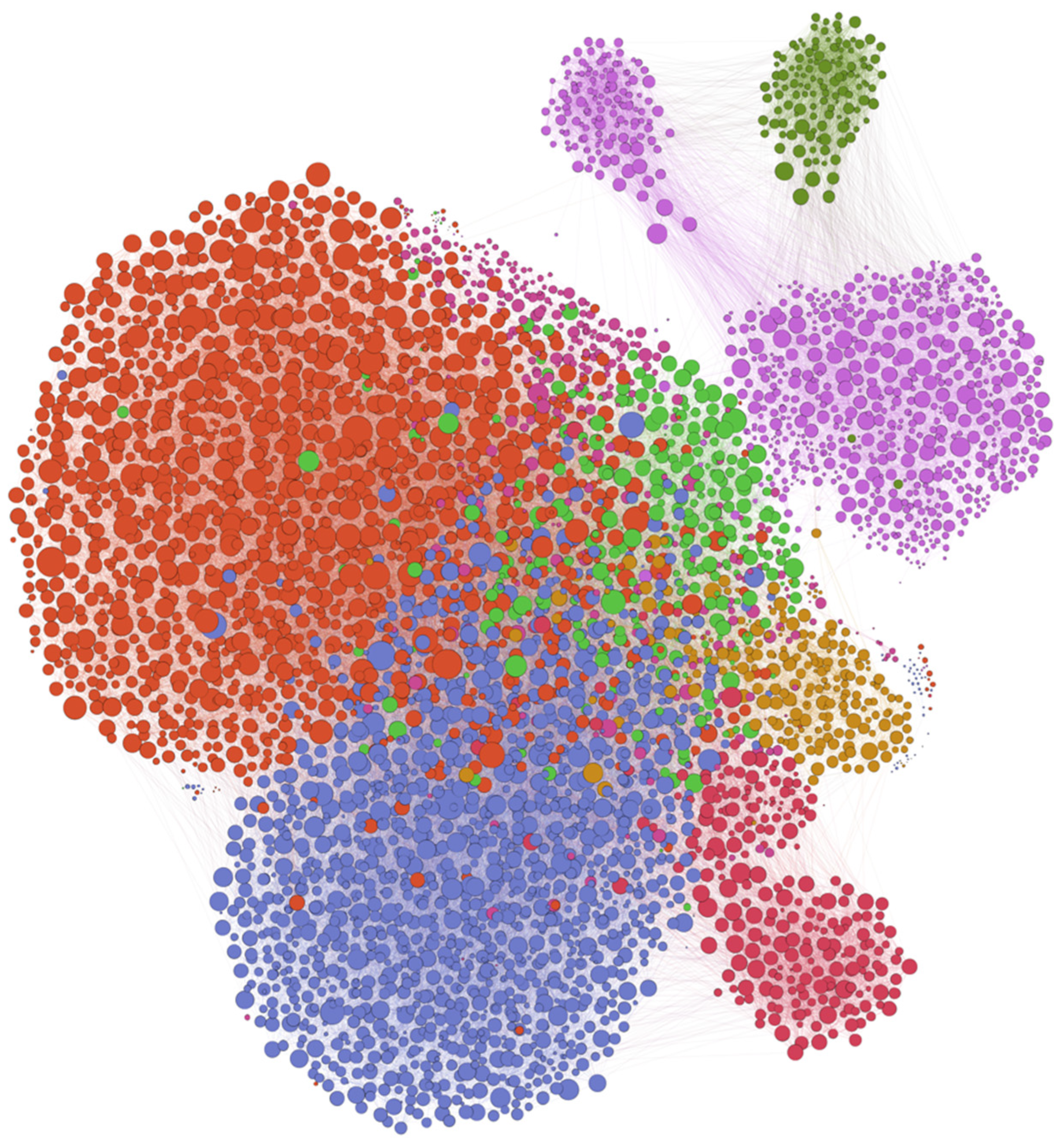
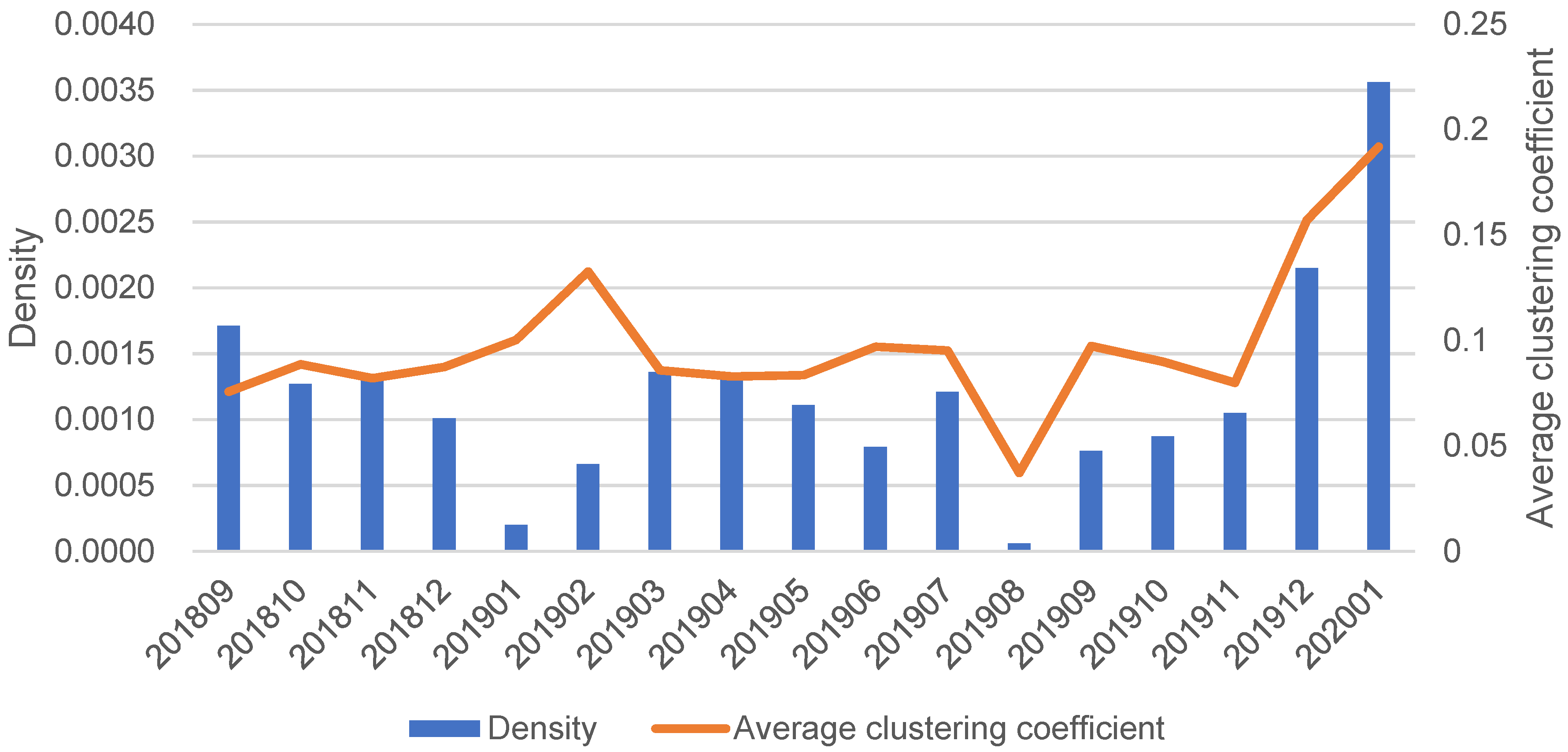
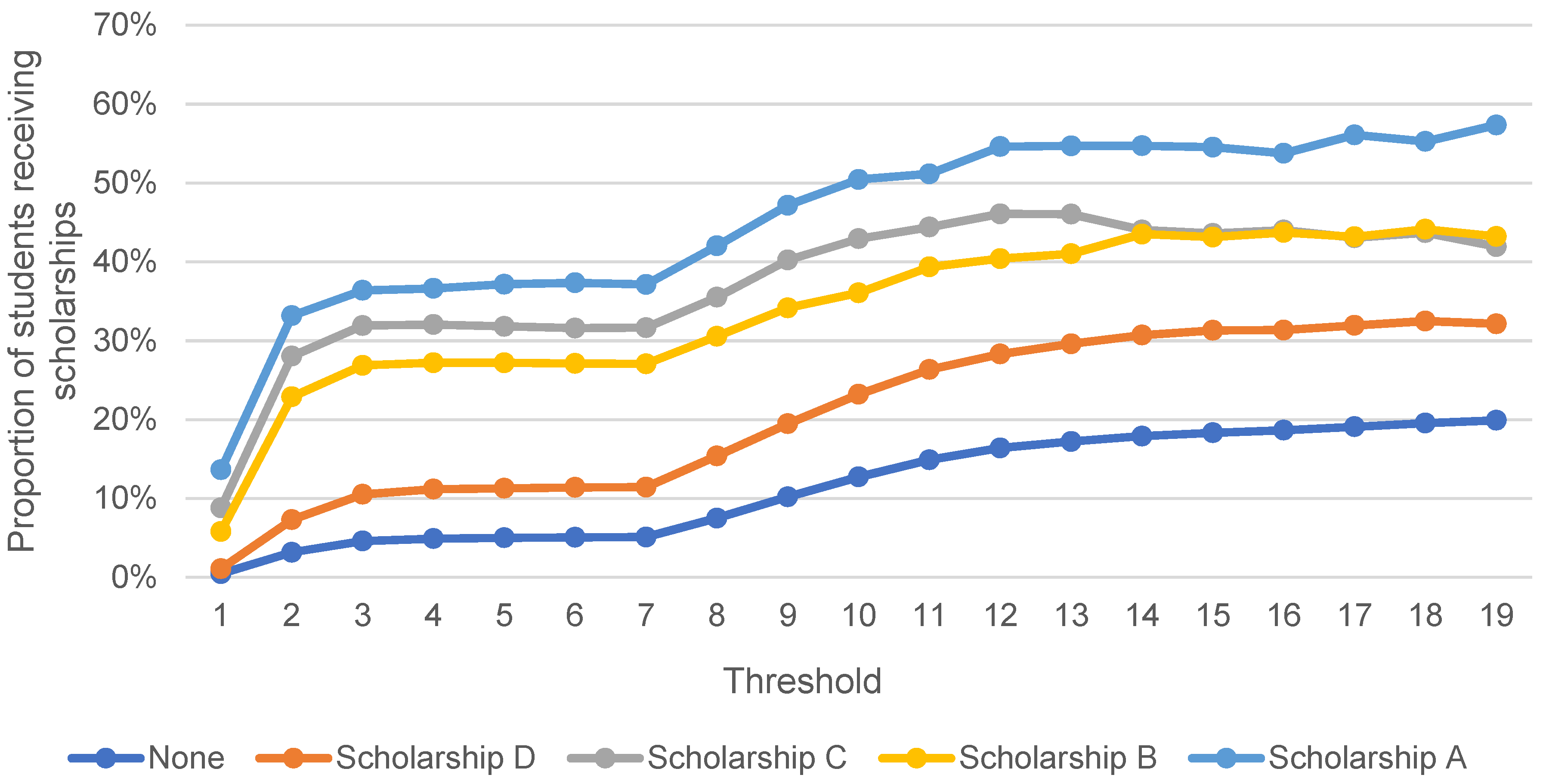
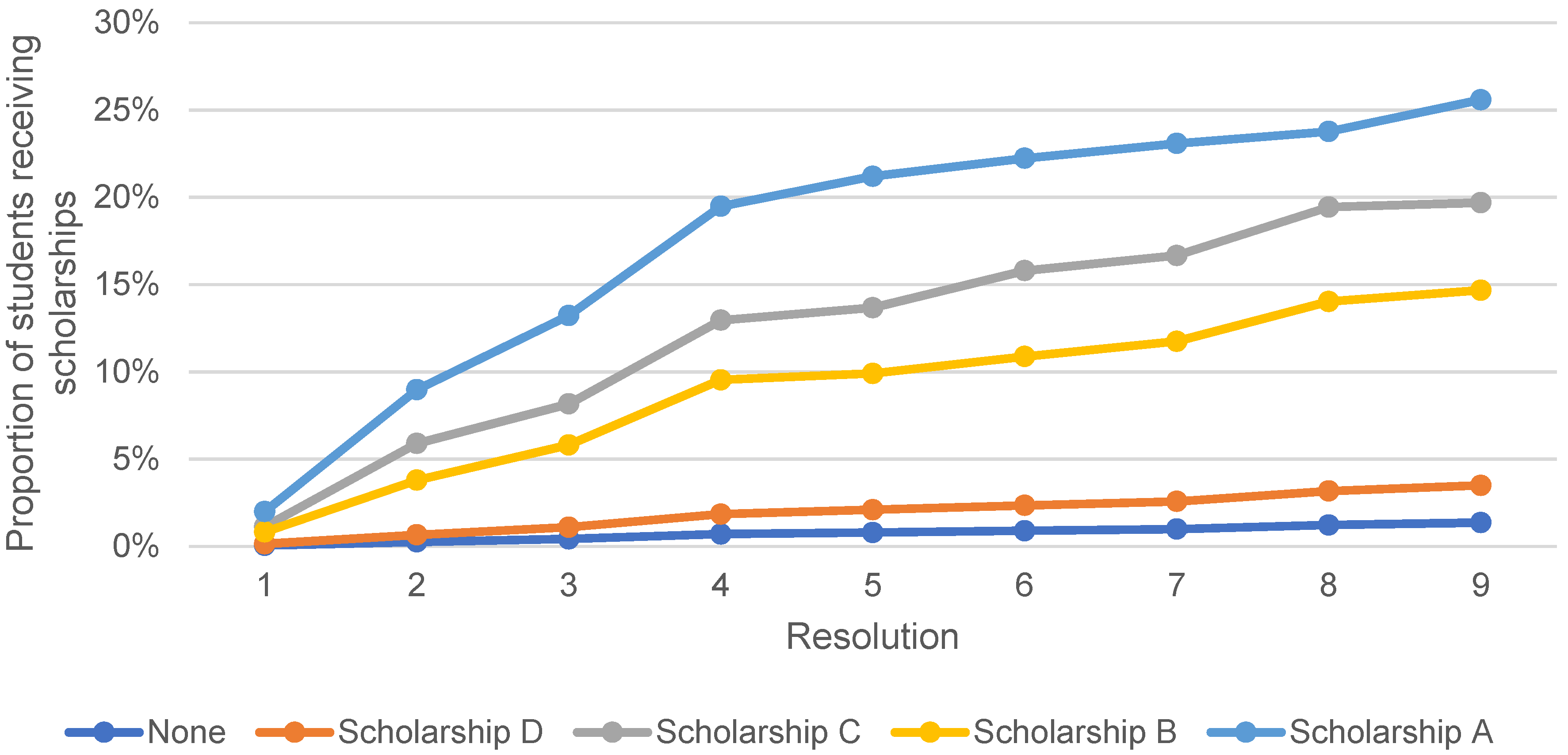
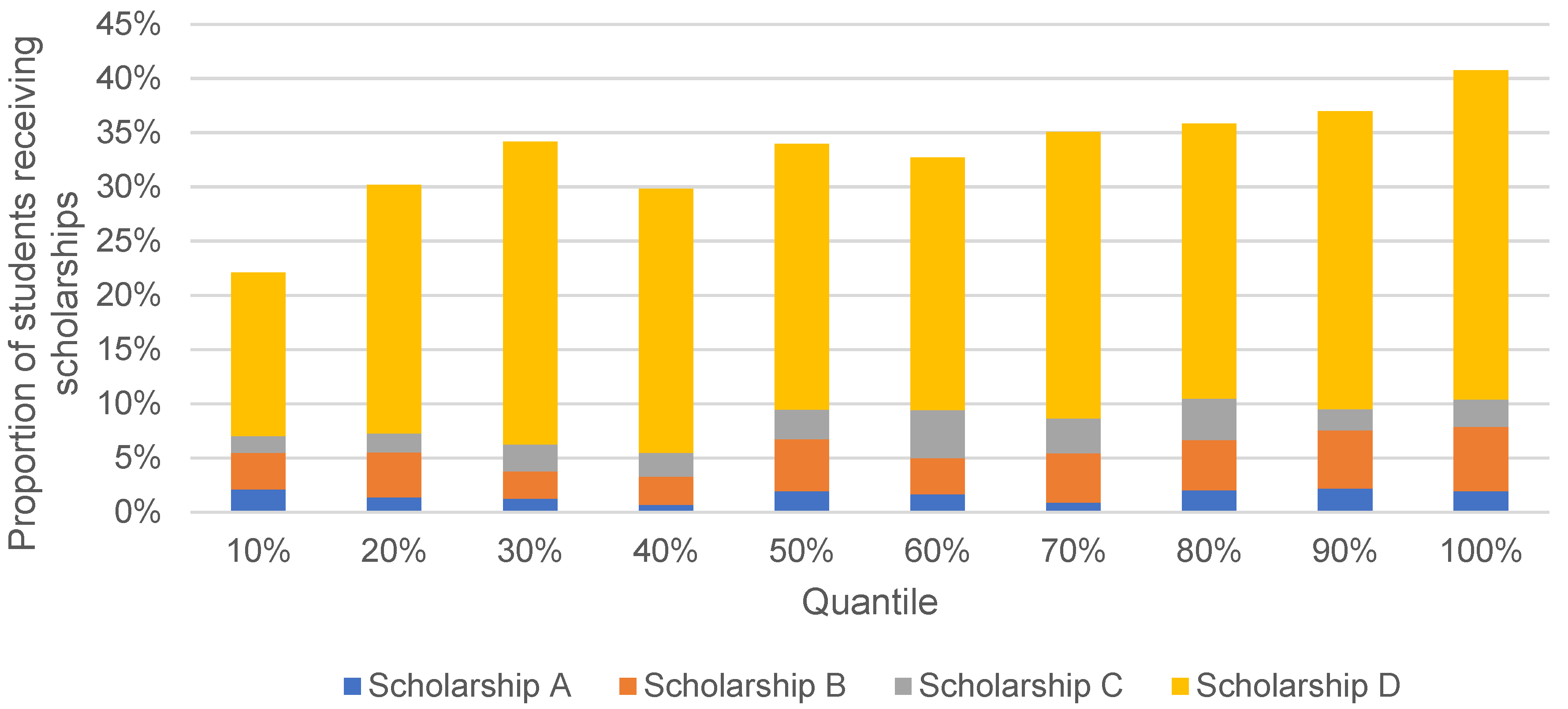
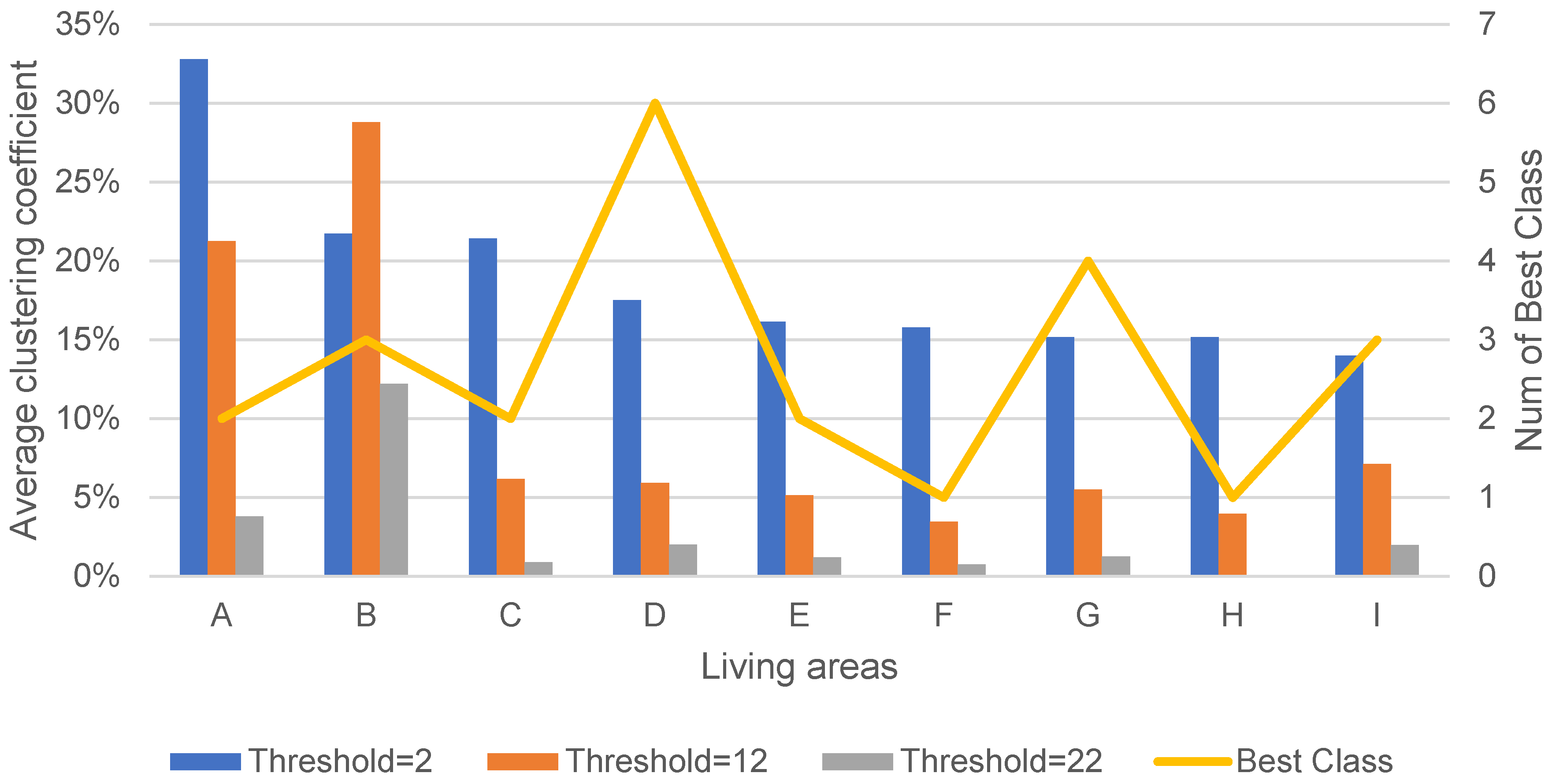
| Characteristics | Category | Count (%) | Characteristics | Category | Count (%) |
|---|---|---|---|---|---|
| Gender | Male | 3223 (68.0) | Hometown | Northwest | 1548 (32.7) |
| Female | 1515 (32.0) | Eastern | 1038 (21.9) | ||
| Campus | a | 3856 (81.4) | Central | 669 (14.1) | |
| b | 882 (18.6) | Northern | 545 (11.5) | ||
| Living area | A | 484 (10.2) | Southwest | 502 (10.6) | |
| B | 398 (8.4) | Northeast | 199 (4.2) | ||
| C | 420 (8.8) | Southern | 193 (4.1) | ||
| D | 391 (8.2) | Hong Kong, Macao, and Taiwan | 44 (0.9) | ||
| E | 743 (15.6) | Scholarship | A | 74 (1.6) | |
| F | 381 (8.0) | B | 196 (4.1) | ||
| G | 721 (15.2) | C | 123 (2.6) | ||
| H | 557 (11.7) | D | 1163 (24.5) | ||
| I | 643 (13.5) | None | 3182 (67.2) |
| Month | Threshold | Province (%) | Class (%) | Dormitory (%) |
|---|---|---|---|---|
| 1 | 2 | 10.02 | 7.95 | 7.95 |
| 5 | 15.39 | 32.11 | 73.69 | |
| 10 | 13.95 | 42.63 | 87.63 | |
| 2 | 2 | 10.31 | 8.23 | 8.39 |
| 5 | 15.69 | 32.91 | 73.28 | |
| 10 | 15.45 | 35.19 | 86.70 | |
| 3 | 2 | 10.23 | 7.68 | 7.46 |
| 5 | 16.62 | 31.23 | 67.96 | |
| 10 | 15.94 | 40.58 | 84.93 | |
| 7 | 2 | 9.30 | 8.75 | 6.48 |
| 5 | 15.27 | 34.15 | 59.80 | |
| 10 | 16.71 | 47.56 | 76.61 | |
| 12 | 2 | 14.33 | 19.03 | 11.03 |
| 5 | 22.41 | 54.82 | 56.27 | |
| 10 | 26.19 | 71.43 | 66.67 |
Disclaimer/Publisher’s Note: The statements, opinions and data contained in all publications are solely those of the individual author(s) and contributor(s) and not of MDPI and/or the editor(s). MDPI and/or the editor(s) disclaim responsibility for any injury to people or property resulting from any ideas, methods, instructions or products referred to in the content. |
© 2023 by the authors. Licensee MDPI, Basel, Switzerland. This article is an open access article distributed under the terms and conditions of the Creative Commons Attribution (CC BY) license (https://creativecommons.org/licenses/by/4.0/).
Share and Cite
Zhou, Y.; Meng, X.; Wang, J.; Mo, X.; Jiang, S.; Dai, C.; Liu, M. Daily Peer Relationships and Academic Achievement among College Students: A Social Network Analysis Based on Behavioral Big Data. Sustainability 2023, 15, 15762. https://doi.org/10.3390/su152215762
Zhou Y, Meng X, Wang J, Mo X, Jiang S, Dai C, Liu M. Daily Peer Relationships and Academic Achievement among College Students: A Social Network Analysis Based on Behavioral Big Data. Sustainability. 2023; 15(22):15762. https://doi.org/10.3390/su152215762
Chicago/Turabian StyleZhou, Yuan, Xiao Meng, Jiayin Wang, Xu Mo, Sa Jiang, Chengjun Dai, and Mengting Liu. 2023. "Daily Peer Relationships and Academic Achievement among College Students: A Social Network Analysis Based on Behavioral Big Data" Sustainability 15, no. 22: 15762. https://doi.org/10.3390/su152215762
APA StyleZhou, Y., Meng, X., Wang, J., Mo, X., Jiang, S., Dai, C., & Liu, M. (2023). Daily Peer Relationships and Academic Achievement among College Students: A Social Network Analysis Based on Behavioral Big Data. Sustainability, 15(22), 15762. https://doi.org/10.3390/su152215762






